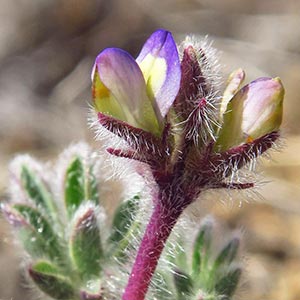Lupinus brevicaulis
Lupinus argenteus
sand lupine, short stem blue lupine, short-stem lupine
silvery lupine
very short, tufted, branched.
erect or ascending, green or purplish, clustered, branched or unbranched.
cauline, crowded near base;
stipules well developed;
petiole 1–6 cm;
leaflets (3 or)5–9, blades 8–20 × 2–9 mm, adaxial surface glabrous.
basal and/or cauline;
stipules 2–12 mm;
petiole 1–15 cm;
leaflets (5 or)6–10, blades 10–60 × 4–10 mm, abaxial surface hairy, adaxial surface glabrous or hairy (but not strigose).
dense, 3–16-flowered, 1–8 cm;
flowers spirally arranged, crowded.
loose, 5–16(–25) cm;
flowers whorled or not.
1–8(–10) cm;
bracts persistent, straight, 2–3 mm.
(1–)4–25(–30) cm;
bracts usually deciduous, 3–4 mm.
0.3–1.5 mm.
(1–)2–5(–7) mm.
6–8 mm;
calyx abaxial lobe entire or shallowly cleft, ± 6 mm, adaxial lobe 2-toothed, 3 mm, less than 1/2 as long as abaxial;
corolla bright blue, banner spot white or yellow, keel glabrous.
5–15 mm;
calyx 4–8 mm, bulge or spur 0–3 mm (may be variable on plant), abaxial lobe entire or 3-toothed, adaxial lobe entire or 2-toothed;
corolla usually blue, sometimes purple, violet, pink, lilac, or white, banner patch yellowish to whitish, blue, brown, or absent, banner not much reflexed-recurved beyond midpoint, this less than 3 mm proximal to apex, banner glabrous or pubescent abaxially, wings glabrous, lower keel margins glabrous, upper margins ciliate.
not undulate, 1 cm, thinly pilose to coarsely hirsute.
(1–)2–3 cm, hairy or silky.
persistent, disclike, sessile.
deciduous, petiolate.
1 or 2, smooth.
(2 or)3–5(or 6), tan, brown, or red.
Lupinus brevicaulis
Lupinus argenteus
Lupinus brevicaulis resembles L. flavoculatus except that its flowers are smaller.
(Discussion copyrighted by Flora of North America; reprinted with permission.)
Varieties 14 (14 in the flora).
(Discussion copyrighted by Flora of North America; reprinted with permission.)
1. Calyx spur 1–3 mm. | → 2 |
2. Flowers in profile appearing open, spur pronounced. | var. heteranthus |
2. Flowers in profile appearing closed; spur less pronounced. | → 3 |
3. Petioles of proximal cauline leaves 1.5–3 cm. | var. argophyllus |
3. Petioles of proximal cauline leaves 3–12 cm. | var. utahensis |
1. Calyx bulge 0–1 mm, but not elongated into a spur. | → 4 |
4. Leaflets oblanceolate, flat, green, surfaces glabrous or adaxially pubescent; plants of cool, moist mountain meadows, stream banks, lakeshores. | → 5 |
5. Corollas pale blue with brown banner patch; pedicels 1–2.5 mm. | var. fulvomaculatus |
5. Corollas usually blue with yellow banner spot or none; pedicels usually 3–4 mm. | → 6 |
6. Stems unbranched and racemes solitary, terminal. | var. rubricaulis |
6. Stems branched, giving rise to several racemes. | → 7 |
7. Corolla wings (7.5–)8–10 mm. | var. argentatus |
7. Corolla wings 5–7.5 mm. | var. parviflorus |
4. Leaflets oblanceolate or elliptic-oblanceolate, narrow and often folded, surfaces gray or silver-pubescent; plants of dry open areas, foothills to mountains. | → 8 |
8. Stem hairs descending in backward direction or widely spreading. | var. palmeri |
8. Stem hairs forwardly appressed. | → 9 |
9. Flowers large, (7–)8–15 mm. | → 10 |
10. Basal and cauline leaves present at flowering. | var. montigenus |
10. Basal leaves absent at flowering. | → 11 |
11. Flowers (7–)8–12 mm. | var. argenteus |
11. Flowers 12–15 mm. | var. moabensis |
9. Flowers small, 5–7(–9) mm. | → 12 |
12. Banners densely pubescent. | → 40g |
40g. Lupinus argenteus var. holosericeus. | → 12 |
12. Banner glabrous or thinly strigulose abaxially. | → 13 |
13. Wings 5.5–7 mm; banner usually thinly strigulose abaxially; Kaibab Plateau, Arizona, Colorado, Nevada, New Mexico, Utah; elevation 2000–2800 m. | var. hillii |
13. Wings 5–6 mm; banner glabrous abaxially; Sierra Nevada, California, adjacent Nevada; elevation 1500–3500 m. | var. meionanthus |


